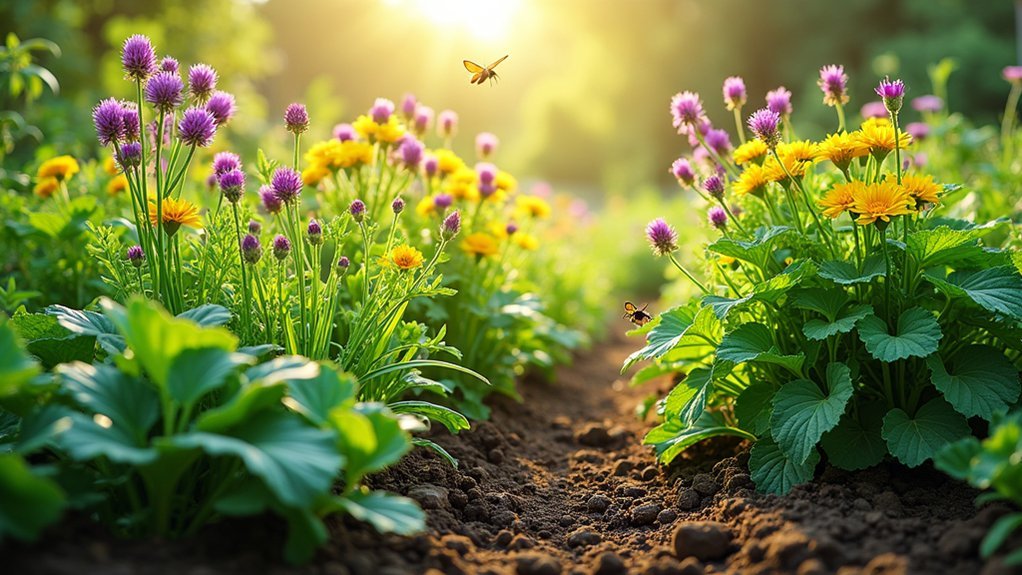Many pollinator-friendly plants double as delicious edibles for your kitchen. Grow herbs like African blue basil, oregano, and lemon balm that bees love. Plant edible flowers such as borage, nasturtiums, and calendula for colorful salad additions. Berries, including raspberries and blueberries, provide food for both you and pollinators. Native plants like persimmon and elderberry require less maintenance, while vegetables like squash and tomatoes offer extended blooming periods. Your garden can become a sustainable ecosystem that feeds everyone.
Delicious Herbs That Attract Beneficial Pollinators

While many gardeners focus solely on ornamental plants for pollinators, your kitchen herbs can serve double duty as both culinary treasures and pollinator havens.
African blue basil produces tall flower spikes that bees adore while enhancing your favorite dishes. Oregano and marjoram aren't just Mediterranean flavor staples—they're magnets for wild bees in your vegetable garden.
Mint's flowers buzz with beneficial insects while providing invigorating additions to teas and desserts.
Lemon balm offers the dual advantages of mosquito repellent and pollinator attraction.
Don't forget to let cilantro, parsley, and dill flower—their delicate blooms attract diverse pollinators, with dill specifically hosting swallowtail butterflies.
Colorful Edible Flowers for Urban Foragers and Bees Alike
Five vibrant edible flowers can transform both your garden and your plate while supporting essential pollinators. Borage and nasturtiums add splashes of color to dishes while attracting bees and butterflies to your urban garden.
Grow what you eat, eat what you grow—edible flowers nourish both your culinary creativity and local pollinators.
Squash blossoms offer dual benefits—they're perfect in quesadillas and omelets while serving as a significant nectar source for pollinators.
Calendula's bright orange petals enhance rice and salads while drawing beneficial insects to native plants.
For tea lovers, Anise Hyssop delivers sweet licorice flavors and keeps bees buzzing happily throughout your garden.
Primrose flowers contribute a mild tang to culinary creations while providing early-season sustenance for pollinators.
These colorful, pollinator-friendly plants create a win-win situation for urban foragers and bees alike—you'll enjoy fresh, beautiful ingredients while supporting vital biodiversity in your environment.
Berry-Producing Plants That Support Local Pollinator Networks

Berry-producing plants serve as powerful magnets for pollinators while providing delicious harvests for your table.
Raspberries and blackberries offer abundant nectar and pollen, creating essential support for local bee populations.
You'll find high-bush blueberries thrive when surrounded by native wildflowers, with increased yields resulting from heightened pollinator activity.
Don't overlook early-blooming strawberries, which attract diverse pollinators and reward you with larger, more abundant fruits.
Native options like serviceberry and elderberry deliver both edible fruits and critical resources for pollinators throughout their blooming cycles.
Edible Native Plants That Strengthen City Ecosystem Connections
Urban gardens present perfect opportunities to reconnect fragmented city ecosystems through thoughtfully selected native plants. By growing edible native plants like common persimmon and high-bush blueberries, you'll not only harvest delicious food but also attract pollinators essential to local ecosystems.
Transform your urban space into a wildlife oasis while enjoying nature's bounty through strategic native plantings.
- Incorporate flowering native plants such as coneflower and goldenrod to support pollinator populations while enjoying their edible benefits.
- Choose native species that require less maintenance and water, making your urban garden both sustainable and wildlife-friendly.
- Surround your food crops with native flowering plants to boost yields naturally, as demonstrated in high-bush blueberry production.
Community gardens featuring these natives promote sustainable practices while fostering environmental awareness and deeper connections between urban residents and their natural heritage.
Multi-Season Vegetables That Create Sustainable Pollinator Habitats

Transforming your garden into a pollinator paradise doesn't require sacrificing food production—in fact, the right vegetables can serve both purposes exceptionally well.
Squash and tomatoes (especially indeterminate varieties) offer extended flowering periods that native bees depend on while providing your kitchen with fresh produce.
Runner beans and fava beans create protein-rich rewards for both you and pollinators. Their vibrant blooms aren't just pretty—these flowers are edible too, adding color to summer salads.
Incorporate perennial vegetables like asparagus and rhubarb to establish permanent pollinator habitats that return yearly with minimal effort.
For maximum impact, interplant your multi-season vegetables with flowering herbs such as basil and dill. This approach creates a thriving kitchen garden that supports beneficial insects throughout growing seasons while keeping your table abundantly supplied.
Frequently Asked Questions
What Edible Plants Are Pollinators?
You can eat many pollinator-friendly plants including fruit trees (apple, cherry), herbs (mint, oregano, basil), squash, pumpkins, fava beans, runner beans, and edible flowers like borage and calendula. They'll nourish both you and beneficial insects.
What Are the Best Non Toxic Pollinator Plants?
The best non-toxic pollinator plants include borage, calendula, anise hyssop, squash blossoms, herbs like basil and mint, and yarrow. You'll enjoy their safety around children and pets while still attracting beneficial insects to your garden.
What Foods Do You Eat That Are Pollinated?
You're eating pollinated foods daily: apples, blueberries, tomatoes, strawberries, and cherries all rely on bee pollination. Your diet also includes squash, fava beans, and herbs like basil that attract diverse pollinators.
What Are Good Pollinator Plants for Vegetable Garden?
Plant fava beans, runner beans, tomatoes, and squash to attract bumblebees and specialist pollinators. Don't forget sunflowers for visual impact and edible seeds. Flowering herbs like oregano, mint, and basil serve double duty in your garden.
In Summary
You'll find that growing pollinator-friendly edibles creates a vibrant ecosystem right in your backyard. By planting herbs, edible flowers, berry bushes, native species, and seasonal vegetables, you're not just setting a beautiful table—you're supporting essential wildlife. Your garden becomes a living connection between urban life and nature's cycles. Best of all, you're harvesting fresh, delicious food while helping bees, butterflies, and birds thrive alongside you.





Leave a Reply